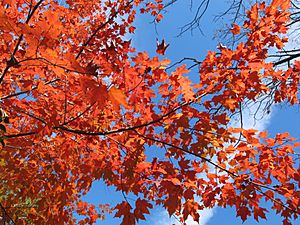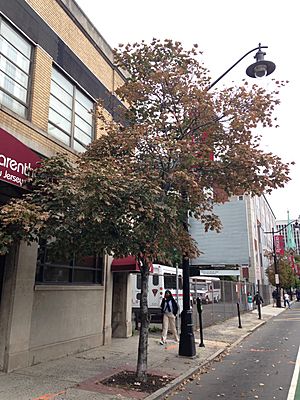Chalk maple facts for kids
Quick facts for kids Chalk maple |
|
|---|---|
 |
|
| Conservation status | |
| Scientific classification | |
| Genus: |
Acer
|
| Species: |
leucoderme
|
 |
|
| Natural range | |
The Chalk Maple (also called whitebark maple or pale-bark maple) is a special kind of deciduous tree. This means its leaves change color and fall off every year. You can find this tree naturally in the southeastern United States. It grows from North Carolina down to northwest Florida and west to eastern Texas. Chalk maples often live in the understory of forests. They like moist, rocky places like river banks, deep ravines, and wooded cliffs. While not super common, you'll most likely spot them in the coastal plain and Piedmont areas of Georgia.
Contents
What Does a Chalk Maple Look Like?
The chalk maple is a small tree. It usually grows to be about 8 to 9 meters (26 to 30 feet) tall. It often has a rounded shape with thin branches and sometimes many trunks. Its name comes from its cool bark! On older trees, the bark is smooth, thin, and a chalky white or light gray color. This is why it's called "chalk maple" and why its scientific name, Acer leucoderme, means "white skin." As the tree gets older, the bark near the bottom becomes rougher and darker.
Leaves and Fruit
The leaves of the chalk maple grow in pairs. They are about 5 to 9 centimeters (2 to 3.5 inches) long and wide. Often, the tips of the leaves droop a little. Each leaf has 5 or 3 pointed parts called lobes. The edges of the leaves can be wavy or have rough teeth. The top of the leaf is dark green and smooth. The underside is yellowish-green and feels soft. In autumn, these leaves put on a beautiful show! They turn bright yellow, then orange, and finally a deep red.
The fruit of the chalk maple is a brown samara. This is a special type of winged seed that helps it fly away from the tree. The samaras grow in pairs and are about 2 to 2.5 centimeters (0.8 to 1 inch) long. They become ripe in the fall.
How is Chalk Maple Different from Florida Maple?
People sometimes mix up the chalk maple (Acer leucoderme) with the Florida maple. But there are a few ways to tell them apart!
- Size: Chalk maples are generally smaller trees than Florida maples.
- Leaves: Even though the chalk maple tree is smaller, its leaves are usually bigger than those of the Florida maple.
- Leaf Color: The underside of a chalk maple leaf is yellow-green. Florida maple leaves have a whitish underside.
- Leaf Shape: The lobes (pointed parts) on Florida maple leaves are more square and blunt. Chalk maple leaves have more pointed lobes.
Both trees have similar gray and white bark. However, the Florida maple's bark tends to curl up more at the edges. In the fall, both trees show off bright orange to red leaves. They also both keep their dry leaves on the branches during winter.
Where Does the Chalk Maple Grow?
You can find Acer leucoderme from North Carolina all the way down to Florida and west to Texas. It's an understory tree, meaning it grows beneath taller trees in a forest. It can even grow in poor soil! You'll often see it on cliffs, along river banks, and in ravines.
Even though it's not super common, the chalk maple is listed as "Least Concern" by the IUCN Red List. This means its population is stable and it's not currently in danger.
Growing Chalk Maples
The chalk maple is a great tree for warmer and drier areas in the southeastern United States. It doesn't need super rich soil to grow. This makes it a good choice for planting in cities or for helping to restore land. You can even grow chalk maples far north of their natural home, up to USDA plant hardiness zone 5B.
This tree is very good at handling shade and dry conditions. If you want to plant one, it's best to collect its seeds while they are still on the tree. This is because the seeds don't stay good for very long and can be easily damaged by insects.
How People Use Chalk Maples
Chalk maples are mostly used as ornamental trees. This means people plant them because they look pretty, especially with their unique bark and colorful fall leaves. Sometimes, they are also used for a small amount of timber.
Protecting Chalk Maples
The International Union for Conservation of Nature (IUCN) says that the chalk maple is not currently facing any major threats. However, there are some things that could cause problems in the future.
- Invasive Species: Trees in the Acer family (maples) can sometimes be attacked by the Asian long-horned beetle. If this beetle spreads further south, it could become a problem for chalk maples.
- Climate Change: Scientists predict that climate change could cause a big loss of suitable places for chalk maples to grow. It's estimated that over 90% of the places where this tree currently lives might not be suitable for it by the year 2050. So, even though it's safe now, it's something to watch out for!



